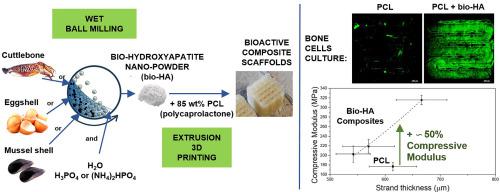Sustainable Materials and Technologies ( IF 8.6 ) Pub Date : 2021-07-20 , DOI: 10.1016/j.susmat.2021.e00318 Francesca Cestari 1 , Mauro Petretta 2, 3 , Yuejiao Yang 1, 4 , Antonella Motta 1, 4 , Brunella Grigolo 3 , Vincenzo M. Sglavo 1

|
Bioactive composites made of ∽85 wt% poly(ε-caprolactone) (PCL) and ∽15 wt% nanometric hydroxyapatite (HA) produced from biogenic sources were 3D printed by an extrusion-based process to obtain porous scaffolds suitable for bone regeneration. Three different composite formulations were considered by using HA synthesized from three distinct natural sources, which were collected as food wastes: cuttlefish bones, mussel shells and chicken eggshells. Composition and thermal properties of the materials were analysed by thermogravimetric analysis (TGA), differential scanning calorimetry (DSC) and x-ray spectroscopy (XRD), while the morphological and mechanical properties of the 3D scaffolds were studied by means of electron microscopy (SEM) and compression tests. Bioactivity was tested by seeding human osteoblast cell line (MG63) onto the scaffolds which were analysed by confocal microscopy and Alamar Blue and PicoGreen® tests after 1 to 7 culture days. The elastic modulus (177–316 MPa) is found to be within the range reported for typical trabecular bones being increased by the presence of the bio-HA particles. Moreover, cells adhesion, viability and proliferation are largely promoted in the scaffolds containing nanometric HA with respect to pure PCL, the best results being revealed when mussel shell-derived HA is used. Indeed, different biological sources result in different cell proliferation rates, pointing that the biological origin has an impact on the cells-scaffold interaction. In general, the results show that PCL/bio-HA scaffolds possess improved mechanical properties and enhanced bioactivity when compared with pure PCL ones.
中文翻译:

用于骨组织工程的生物源来源的 PCL/纳米羟基磷灰石支架的 3D 打印
由 ∽85 wt% 聚(ε-己内酯)(PCL)和∽15 wt% 纳米羟基磷灰石(HA)制成的生物活性复合材料通过基于挤出的工艺进行 3D 打印,以获得适合骨再生的多孔支架。通过使用从三种不同的天然来源合成的 HA,考虑了三种不同的复合配方,这些来源作为食物垃圾收集:墨鱼骨、贻贝壳和鸡蛋壳。通过热重分析 (TGA)、差示扫描量热法 (DSC) 和 X 射线光谱仪 (XRD) 分析了材料的成分和热性能,同时通过电子显微镜 (SEM) 研究了 3D 支架的形态和机械性能。 ) 和压缩测试。通过将人成骨细胞系 (MG63) 接种到支架上来测试生物活性,在培养 1 到 7 天后通过共聚焦显微镜和 Alamar Blue 和 PicoGreen® 测试进行分析。发现弹性模量 (177–316 MPa) 在报告的典型小梁骨因生物 HA 颗粒的存在而增加的范围内。此外,相对于纯 PCL,在含有纳米 HA 的支架中,细胞粘附、活力和增殖在很大程度上得到促进,当使用贻贝壳衍生的 HA 时显示出最好的结果。事实上,不同的生物来源导致不同的细胞增殖率,表明生物来源对细胞-支架相互作用有影响。一般来说,











































 京公网安备 11010802027423号
京公网安备 11010802027423号